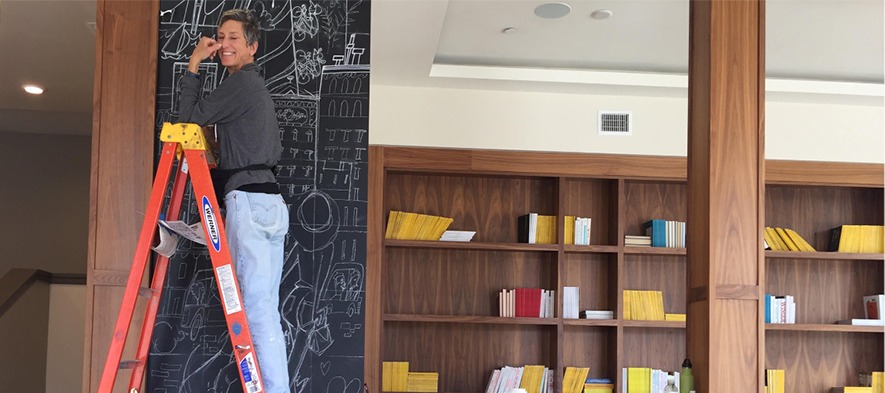Creator Spotlight with Illustrator Cindy Salans Rosenheim

This week we would like you to meet Illustrator Cindy Salans Rosenheim.
I’m afraid to admit that I backed in to Illustration as a career. My mother was a fine artist and my father was a doctor. I attended Tufts University so it would have made sense to study medicine, which I considered. However, instead, I decided to study Art History and French.
The real problem came after school when I needed a job. As it turned out, a San Francisco interior designer was redoing the Whitehall Hotel in Houston, Texas, and needed a muralist for a restaurant there.
I had drawing ability – not much more – but I was definitely the right price! So I found myself an artist in residence at the Houston Whitehall, where (out of sheer fear) I managed 5 wall murals and a watercolor painting that was gifted to the outgoing hotel manager. It was my first job and I had an instant portfolio, which I carried along when I snuck in to a portfolio review session with the Hallmark Card recruiters at a local art school.
Hallmark Cards hired me three weeks later. It was there that I learned the business of commercial illustration, and after 2 _ years I went out on my own.
No doubt, I could have made more cash as a doctor, but I wouldn’t have confronted the “struggle, ” or reaped the freedom and the delight, of working as an illustrator.
For me, the best part of the creative process is in the middle – and sometimes, during a struggle, something unintentional and surprising happens. Your pen slips, you work the wrong Photoshop key arrangement, or out of frustration you draw or paint something tha’s at complete odds with your intention. But you find or discover a wholly new solution or approach to your piece. And – here’s the payoff – that wonderful little squirt of dopamine hits the brain!
My procedure for assignment illustration looks like this:
- Thrill to the challenge of a new job.
- Work out the cost of the job, taking in to consideration what it will be used for, the scope of its reach, how many rights belong to it, and then the size and complexity of its execution. Converse (normally by email) with the client and come to an agreement on fees. Draw up an agreed upon contract and have it signed.
- Panic. How will I ever get this done in the time allotted? Am I the right artist for this assignment? I can think of a million artists who are better suited. How can I possibly come up with fresh ideas for this thing? I’ve forgotten how to draw!
- Go the gym.
- Start to gather visual material, whether online or from my files or from gazing out my studio window, and start rough sketching. The hunt for visual reference informs the sketching and the sketching, in turn, drives me to new visual inspiration.
- Once I settle on an idea, I work it out in detailed pencil and submit it – or usually a few ideas – to the client.
- Once the drawing is approved, I work to finish it. I work traditionally with pen and ink and an old fashioned croquille pen, and then gouache or watercolor on top. This gets scanned into Photoshop where I can fiddle with the design, colors and shapes. Hopefully, along the way, that aforementioned dopamine squirt keeps me happy.
I do a lot of chalkboard illustration as well. Big boards, wall boards, interiors and exteriors. In this case, the procedure is simpler. Normally, there is lettering involved so I start with that. Block, Blackletter, “funkified, ” calligraphic, typewriter style, etc. The accompanying illustration embellishes the letters and takes inspiration from their shape and the subject matter they describe.
Aside from billing, which involves charge for a service and a one-shot deal end-product, the procedure vis a vis the client is the same: Contract, sketch approval, finish.
The biggest misconception about illustration that I’ve found is the one about how easy it is. “Oh, you’re so lucky to be an artist. You just sit at your desk and these wonderful images come forth! ” “You mean you can’t letter and illustrate this 8′ X 8′ board by the day after tomorrow’s board meeting? How long DOES it take you? “
The great designer Milton Glazer talks about the thought and energy that goes into the profession. In fact, his massive coffee table book, which was issued in 2000, is called Art is Work. Because it is.
In this age of omnipresent images, i’s difficult to protect one’s art from infringement. I’s also hard to keep from being influenced by those images ourselves as artists! There is so much out there, and some of it will find its way in to the world of image cross-pollination. Having said that, i’s wise to legally protect the pieces important to your portfolio. To do so, you must legally retain full rights to all illustrations that you sell, negotiating the rights to the use(s) of the artwork, not the artwork itself (unless you are negotiating a full buyout of the image, in which case you would be selling the copyright as well). In addition, i’s wise to register your art with the U.S. Copyright Office.
Are you one of our Individual Creator Members? Participate in our Creator Spotlight series! Please email us at cawebsite@copyrightalliance.org. And if you aren’t already a member of the Alliance, you can join today by completing our Individual Creator Members membership form!

